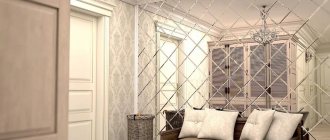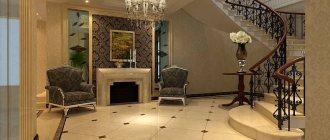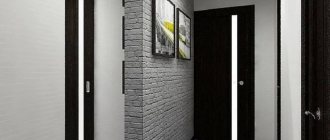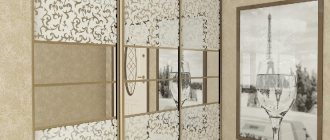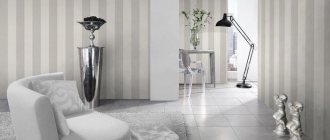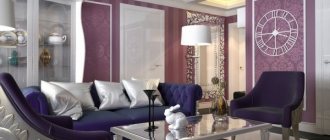02.06.2018
Porcelain tiles in a modern interior are not only a new fashion trend, but also reliability and durability of the floor covering, high wear resistance and durability and, of course, visual appeal. To understand where it is best to use it, you need to understand all the advantages and disadvantages that the material has in general, and also take into account the peculiarities of its use in certain parts of the house, and also understand whether all the advantages of porcelain stoneware will always be appropriate for a specific room and, if possible smooth out the imperfections of the material.
Types of porcelain stoneware
Matt (unpolished)
Matte porcelain tiles in the garage Gres 30*30 cm (Cersanit, Russia).
Unlike other types, this one does not undergo additional processing after leaving the oven. Matte porcelain floor tiles do not differ in aesthetics, but this is compensated by their enormous strength, the highest among all classes. On the ten-point Mohs scale, in which diamond ranks highest, the unpolished form is in position 8-9. It is very difficult to accidentally scratch it, and it does not react to the fall of small metal objects.
Due to its wear resistance, it can be used in the most crowded places and places with high load on the material: garages, car washes and other technical premises. The rough surface makes the tile highly anti-slip, and the minimal porosity makes it moisture resistant. The last point applies to all types, which makes porcelain floor tiles able to withstand temperature fluctuations and severe frosts.
Polished
By treating the surface of matte porcelain stoneware with abrasive materials, a shiny polished surface is achieved. The decorative properties of this species open the doors of status institutions to it. In addition to gloss, ceramic granite receives a rich and deep color.
Polished porcelain stoneware 120x60 cm from the Ural facades collection (Ural granite, Russia). Can be used for cladding floors and facades.
The downside of polishing is a slippery surface and a weakening of the tile structure. Removing the top layer reduces the density of the ceramic, which leads to a decrease in strength and water-repellent properties. To reduce the negative impact of the liquid and increase the friction force, it is recommended to rub the slabs with wax. Polished porcelain tiles are not very suitable for flooring; it is better to use them to cover facades. But, despite the risk of injury, especially in rainy and winter times, people everywhere turn a blind eye to this - regarding the use of this type, floors are still more popular than walls.
Lapped (semi-polished)
Like porcelain stoneware, lappatting technology was developed by the Italians. The tile surface is polished superficially, as a result of which it becomes heterogeneous. Polished areas are mixed with rough ones that have not been processed at all. Depending on the design idea, the arrangement of zones is random or filled with a semantic component.
Lapped porcelain tiles Ampato (CF Systems, Russia).
For the consumer, this means a combination of the beauty of the polished type and the durability of the matte type. Navigating between aesthetics and operational parameters cannot but please designers, who get the opportunity to decorate passage areas with material with high decorative properties.
The Playa collection (Meissen Keramik, Germany) imitates natural rocks with quartz veins. Suitable for floors and walls indoors and outdoors.
Satin (polished)
To obtain a velvety and visually soft surface, mineral salts are added to the top layer of satin porcelain floor tiles. The wear resistance of the “salted” type is almost on the same level as that of matte artificial stone, while the polished type performs decorative functions no worse than the polished one. Moreover, unlike the latter, it slides much less.
Satin finish makes the surface matte and velvety. The photo shows the Xtra ordinary collection (Graniti Fiandre, Italy).
The disadvantage of satin finish is the relatively low strength of the product. It is not recommended to install it in public places. The negative aspects include the high cost of tiles.
Structured
If you are going to lay porcelain stoneware on the floor, it will have a relief texture. This is a matter of taste and a matter of price, but structured artificial stone has many advantages. The technology involves imitation of all kinds of materials with tiles. Wood, travertine, brick, marble... The world of relief porcelain tiles is huge, which is why interior designers love it.
A collection of porcelain tiles imitating mosaics from natural Toledo stone (Keramin, Belarus).
Aesthetic advantages intersect with the advantages of the technical sphere. The ceramic relief helps to effectively resist slipping - one of the most dangerous factors associated with porcelain stoneware floor tiles.
Porcelain tiles Riverstone (Navarti, Spain) with relief pebbles.
The floor in the bedroom is made of wood tiles. The MDE LONG collection (Emigres, Spain) has a long board format - 120x20 cm and 6 options for the color and texture of natural wood.
Glazed (salted)
This type is the closest relative of ordinary ceramic tiles. They are connected by a layer of glaze covering the facing material. In the production of smalt granite, double pressing technology is used. Vitreous enamel is “repressed” onto the compressed composition of clays and dyes. The result is an unlimited palette of colors and compositions.
The Sicily collection (ColiseumGres, Russia) consists of square slabs with a format of 45x45 cm.
Glazed porcelain tiles cannot be used in public places. Despite the powerful backing and enamel, which is stronger than regular enamel, the two-component material is inferior in strength to other, monolithic types.
Mosaic
Technical porcelain stoneware 20x20 cm (Estima, Russia).
Using waterjet cutting, you can make mosaics from porcelain stoneware and assemble unique designs.
Ceramic granite is a very strong material. Still, strength depends on dimensions. All other things being equal, the smaller one is stronger. Well, you can’t compete with mosaic; its small area makes it invulnerable to accidental or targeted breakage. Miniature size also affects the creative side of the issue; even a small surface can be paved with hundreds of elements, which can be combined in thousands of ways.
Installation options:
- abstract drawings;
- geometric patterns;
- combination of styles and patterns;
- chess layout, etc.
Rectified
Previous types, with the exception of mosaic, differed in the structure of the material. Edged ceramic granite differs from others in caliber and silhouette. Coming out of the oven, the tiles have geometric flaws invisible to the eye - this is the specificity of mass production of porcelain stoneware. Rectification allows you to achieve ideal straightness of the tile contour. The edges of the material are cut using special machines using a laser or a mixture of water and abrasive.
Rectification makes the seams between the tiles almost invisible. The photo shows the Stage collection (Italon, Russia).
Rectificate can be laid without seams. This increases the solidity of the coating and its aesthetic functions. But do not use edged tiles in places with temperature changes and in rooms with constant heating. The absence of seams entails rupture of the binder mixture and damage to the tiles.
Color palette
Since the range of ceramic coatings on the modern market is wide, the choice of color scheme in the living room depends only on the taste of its owner.
- For connoisseurs of bright interiors, white, gray, beige tiles for floors and walls are suitable.
- Black color makes the space heavier, and it is also an impractical solution for the floor, since dirt and damage are clearly visible on it.
Today, manufacturers offer companion materials for wall decoration: pre-selected shades and patterns will help to professionally transform the interior of the living room.
The photo shows a bright living room with bright color accents. The “heavy” beamed ceiling is successfully compensated by the white floor.
Terracotta flooring is suitable for a country house: such a floor looks natural and cozy.
Tiles in rich colors - yellow, red, green - will become a bright accent in the interior. To avoid it being overloaded, the rest of the decor should be selected in neutral colors.
Characteristics of porcelain stoneware that you need to pay attention to
Strength
We mentioned this option above. On the MOHS scale, matte porcelain tile is second only to diamond, leaving marble and granite behind. Despite the varying degrees of strength, any type of artificial stone surpasses most finishing materials in this parameter.
Mohs scale. For example, ordinary sand has a hardness of 7. Therefore, when laying, you must immediately remove the remaining mixture from the surface and seams so as not to damage the coating before use. Lay a rug on the floor in the hallway that will collect all the sand from the street.
Moisture resistance
Low porosity ensures almost complete absence of water absorption - up to 0.05%. Thus, rooms and facades can be decorated based on this aspect using any type of porcelain stoneware. Thanks to the hydrobarrier, the material tolerates temperatures down to -50. Conventional ceramics, due to their absorbent structure, are quickly destroyed at subzero temperatures.
Wear resistance
Abrasion resistance is measured on the PEI scale, which is graded into five classes:
- I – wall ceramic granite;
- II – porcelain stoneware for the floor of residential premises with low traffic;
- III – slabs for medium-traffic areas (up to hundreds of people per hour);
- IV – ceramic granite for public places with traffic up to several hundred people per hour;
- V – porcelain tiles for the floors of areas with the most intense traffic (stations, airports);
The packaging, which always indicates the class of the tile, will help determine the appropriate material.
Designation of pictograms on packaging with tiles.
Format
Porcelain tiles imitating natural stone 30x30 cm Keope Ceramiche Alpi (Italy).
The size of porcelain tiles is related to the area of the room. Large tiles in a small area almost always look worse than small ones. The format is associated not only with design, but also with the durability of the cladding. Ceramic granite 600x600 mm requires a better base and higher quality adhesive than tiles measuring 30x30 cm. The golden mean is 45x45 cm; such slabs are not bad, from a design point of view, for any room. In addition, they are very convenient to install: they provide high speed and adequate response to small flaws in the base plane.
Thickness
Porcelain tiles for flooring are produced in thicknesses of 7-30 mm. The thicker, the more durable. The parameter is directly related to the degree of abrasion.
Load resistance
The maximum load that ceramic granite can withstand, according to one classification, is 2000 N. The bending strength is 45–55 MPa. For comparison: the UNI EN 14441 standard is 27 MPa. Specific indicators depend on the thickness, size of the tile and load. The video shows the strength testing of porcelain stoneware. A 30-ton truck drives over large-format slabs.
No. 5. Are porcelain tiles and tiles the same thing?
Many people mistakenly believe that these are really the same type of flooring, they just decided to shorten the name and raise the cost... But this is far from the case. differences significant ones at that :
- Porcelain stoneware undergoes heat treatment at significantly higher temperatures than tiles, which explains its higher strength and wear resistance .
- Due to high temperatures, the components of porcelain stoneware literally melt during processing, which completely eliminates the appearance of micropores . This prevents moisture from entering the internal structure, so porcelain stoneware can withstand high sub-zero temperatures without cracking. Tile has a porous structure and cannot withstand large temperature changes.
- Porcelain tiles are easy to clean - due to the absence of micropores, the surface becomes less dirty. A damp cleaning is enough to maintain its beautiful appearance.
- Porcelain tiles are absolutely resistant to any chemicals . This makes the cleaning process easier. Tile does not tolerate aggressive substances well and can lose its shine when exposed to, for example, alkali.
- Cracks and chips do not form on the surface of porcelain stoneware, even after a long time . Despite the fact that on tiles you can observe microcracks on the surface after just a couple of years of use.
- Porcelain tiles, due to their resistance to ultraviolet radiation , will not lose their color and clarity of design even after 50 years, which cannot be said about tiles, which fade over time.
- practically no stains . Have you noticed that when laying tiles, the adhesive mixture sometimes appears on the surface and has to be changed, since this is an irreversible process? This will never happen with porcelain stoneware due to its monolithic structure . Even if you spill a coloring substance on the surface of porcelain stoneware, it can be easily removed without leaving a trace.
- Porcelain stoneware has a high bending resistance , which allows it to be laid even on uneven surfaces. The tile breaks at the slightest distortion.
- The best porcelain tiles have absolutely smooth and clear edges, which allows you to perform seamless styling.
Performance characteristics of porcelain tiles for flooring
The choice in favor of porcelain tiles is due to the high performance characteristics of the coating being formed. We suggest you get acquainted with the main parameters so that when purchasing it will be easier for you to make a choice in favor of one or another variety.
Performance may vary
Durability and abrasion resistance
The strength and abrasion resistance of porcelain stoneware floor tiles largely depends on which wear resistance class group it belongs to. In accordance with regulatory requirements, the division is made into classes:
- PEI I. Lowest strength characteristics. The tiles can be laid in places with minimal traffic;
- PEI II. It has higher strength characteristics than the previous version, but the scope of use is limited;
- PEI III. Able to withstand moderate mechanical stress. Some are installed in apartments and offices;
- PEI IV. Due to its good resistance to abrasion, it can be installed in high-traffic areas. A current option for the vestibule, hall, stairs, etc.;
- PEI V. The most wear-resistant option. Can be installed in public places inside and outside buildings.
The abrasion class determines the location of laying porcelain tiles for the floor
Moisture resistance and load resistance
The moisture resistance of porcelain tiles is of fundamental importance for unheated rooms and those operated in conditions of high humidity. The less the material absorbs moisture, the longer it can last, since water seeping inside after freezing will certainly destroy the tile. This parameter depends on the type of porcelain stoneware. For glazed it is only 0.1%, for unglazed it can reach 0.5%. For comparison, ceramic tiles can absorb 3.5-4.5% moisture.
Porcelain tiles for flooring have a fairly high hardness, and therefore resist external loads well. On a ten-point scale, high-quality porcelain tiles for flooring are assigned 7 points.
Can be installed in bathrooms and kitchens
Other characteristics
Porcelain tiles are not afraid of exposure to most aggressive chemicals. However, the ingress of hydrofluoric acid is unacceptable: the floor covering will be damaged.
Porcelain tiles for flooring have maximum frost resistance, as evidenced by the special marking on the packaging: “snowflake”. This makes it possible to use it for the design of floor coverings not only indoors, but also outside buildings.
Porcelain tiles are widely used in the design of local areas
How to choose adhesive for porcelain tiles
Porcelain stoneware is characterized by high density, which allows it not to absorb moisture. This indicates the need to approach the choice of glue with special care. In this case, you need to know certain requirements for the gluing composition:
- excellent adhesion contributes to a better connection, but porcelain stoneware has a dense structure, so the adhesive must have additional gluing properties.
- mechanical resistance says that the material has considerable weight, so the adhesive must have high mechanical resistance properties. The thickness of the glue should be equal to the thickness of the material.
- additional requirements are determined by the characteristics of the material, for example resistance to water and frost resistance, which means the adhesive must meet them. Sometimes porcelain tiles need to be installed at low temperatures, which means that the adhesive must be fast-setting.
When choosing glue, it is important to focus on the base material; the glue must match this material. It should be understood that the installation of porcelain stoneware is a complex procedure, and the conditions for applying the composition must be observed, for example, do not turn on the heating.
Tile in the living room is not a completely traditional way of finishing walls and floors; it is still gaining popularity. The installation of ceramics in bathrooms and kitchens is determined by the humidity of these rooms, but in the living room its use is purely decorative.
Errors when purchasing
- Don’t overpay for expensive structured (satin, smeared) porcelain tiles for the floor to clad the technical room.
- The same relief material is beautiful, but not effective for street cladding. Dirt clogging between textured areas makes it difficult to care for ceramics.
- Cheap porcelain tiles can be poorly sized.
- Buying slabs from different batches is fraught with tonal differences.
Laying porcelain stoneware on the floor is preceded by a meaningful choice of material. The choice is determined by the purposes of the cladding and the characteristics of the tile. As a result, the advice boils down to one recommendation: try to match the tasks and properties to each other. Correlate what you learned with the expected result and what is written on the packaging of ceramic granite.
Photos of the living room in various styles
The tiles in the living room will fit well into the modern style. It is characterized by minimalism and clear lines. For the living room, a monochromatic covering without pronounced patterns is suitable, which will serve as a backdrop for an advantageous display of furniture and accessories.
The classical direction is the complete opposite of the modern. Classic interiors are replete with decorative details. For finishing, materials are suitable that will emphasize the nobility and tranquility of this style: light colors, patterns, marbled imitation. For the floor, a good solution would be a coating that imitates dark parquet.
Main advantages
Many homeowners have chosen to use porcelain tiles for their floors. This is explained not only by its increased strength and durability. Ceramic stone has a number of other advantages:
Advantages
| Moisture resistance | The idea of pressing powder under very high pressure is to reduce the number of pores in the ceramic and increase its density. As a result of this treatment, ceramic tiles become completely invulnerable to water: the water absorption coefficient is a tiny value - 0.01%. |
| Frost resistance | The material will withstand exposure to t = –50 °C, more than 100 freezing cycles. Its resistance to low temperatures is explained by its immunity to moisture - there are no pores in the block, liquid does not penetrate inside, and the tile does not collapse when frozen. It can last more than 100 years even at very low operating temperatures. |
| Good thermal conductivity | This is the most suitable material for finishing heated floors. It transfers the heat generated from below to the surrounding space almost without loss. |
| Increased wear resistance | The fifth category PEI V according to the international classification means maximum abrasion resistance and the possibility of use in areas with heavy traffic. |
Porcelain tiles compare favorably with other types of coatings
Due to their good thermal conductivity, porcelain tiles are perfect for installing heated floors
This list of product advantages can be continued: in technical parameters it surpasses all other types, has almost no disadvantages, but is more expensive.
Country style bathroom
Cozy living room of a country house in beige tones
Take note! Products intended for installation on the floor are marked with a special icon - a drawn foot. The darker the pattern, the more wear-resistant the tiles are.
Porcelain tiles for walls and its types
According to the types of processing and the shape of the material, it can be as follows:
- matte type, is in demand, relevant for updating the facade of buildings. The manufacturing technology does not provide for processing after the firing procedure. Such porcelain tiles do not have shine, they do not contain additional substances, which makes the cost of the products quite affordable. But at the same time, the matte version has the following advantages: a high degree of resistance to low temperatures, temperature changes, mechanical stress, etc.
- polished type, this is produced by firing, the field of which is treated with abrasive substances. This method allows you to achieve a mirror shine. The shade differs in depth. This type of material should not be used as a flooring, as it can easily slip. Best used for decorating walls.
— semi-polished type is produced in the process of cutting and further polishing the finished material. This allows the matte surface to alternate with a glossy one, which gives the product an excellent appearance. Such products are relevant for arranging wall surfaces. The price of this type will be higher than that of its analogue.
— polished type (satin) has a soft shine. Porcelain tiles are made by grinding the finished material using mineral salts. This process is performed before the piece is fired. The main advantage of the product is its dirt-repellent effect, which allows it to be used in institutions with high traffic volumes.
- glazed type (smalted) is produced by analogy with the creation of ceramic products. A glaze coating is applied to the finished product, and then the material is fired. The material is relevant when arranging walls; if used on the floor surface, it will be dirty within a month.
- textured type will require the use of a mold; such porcelain stoneware is very similar to natural material.
— rectified type has specified dimensions, packaged in tiles. the material resembles artificial stone used for decoration.
- mosaic type is known in two versions - having a glossy sheen or a matte finish. Due to its small size, installation of this material is difficult.
When classifying porcelain stoneware according to coloring, one should distinguish the material into homogeneous and partially colored. The first option is characterized by resistance to wear, since it contains natural coloring compounds.
In addition, the material is harmless and environmentally friendly. For a material with a partial coloring option, it is typical to use two shades. This material is not as wear resistant as the first one.
Porcelain tiles for the floor. Examples of use (photos)
The exceptional quality characteristics of ceramic granite allow it to be used for flooring in a wide variety of rooms, buildings, and under different operating conditions. The ability to combine tiles in size, texture, and color allows consumers to create unique combinations of materials and get interesting panels.
Porcelain tiles for kitchen floors (photo)
Porcelain tiles on the kitchen floor
Grease and splashes of water make the use of polished porcelain tiles not very practical for the kitchen. And although the tiles do not absorb dirt, moisture and grease, there are no streaks on them, it is better to lay embossed ceramic granite on the kitchen floor (photo) - with imitation marble (for classic interiors), bright colors "monocolor" - for the "modern" style , use graphite, black or milky white tiles - for the “high-tech” and “minimalism” style.
For bathroom
Porcelain tiles on the bathroom floor
For flooring in the bathroom, you can use corrugated porcelain stoneware, and lay the walls glazed. In the bathroom, white gres on the walls can look hospital-dull. To remove the “hospital room” effect, monocolor is diluted with decor. If you use milky white ceramic granite in combination with satin black tiles, you can get a bright interior in a classic “checkerboard” design.
A horizontally elongated decorative pattern will visually expand the space, while narrow vertical patterns will raise the base. Another interesting design technique is to lay out the bathroom with tiles with a wood-like texture; modern technologies make it possible to obtain photorealistic images, and you can get the interior of a wooden bathroom.
Gres on the living room floor
Porcelain tiles on the floor in the living room
The living room is a room in which it is customary for the whole family to relax or spend leisure time with guests. Polished porcelain stoneware tiles come in handy here: the ceiling lights will play reflections on the surface of the tiles, creating a permanently festive atmosphere. For light interiors, the colors “ivory monocolor”, “orange-peach monocolor”, “light milky monocolor”, etc. are suitable.
You can also lay the floor with satin porcelain stoneware; its pleasant shine will give the room a special chic. To create a “loft” style, wide slabs of gres in the colors “light gray monocolor”, “dark gray salt pepper”, “polycolor amba graphite”, etc. are suitable.
Ceramic granite for porch flooring, steps and stairs
Porcelain stoneware steps
Stairs finished with gres look presentable and attractive. Matte or embossed, glossy porcelain tiles are used to cover steps and stairs, as they have a non-slip surface. What color to choose for the steps depends on the exterior of the building. The most popular colors are gray, asphalt, amba, black, grey, red, deep red.
The steps of the stairs are finished with tiles of a special size - 1200x295x11, the steps are also laid out with tiles in the 300x300 format.
Ceramic granite for flooring on terraces and adjacent areas
Porcelain tiles on the terrace floor
Spectacular terraces and paths near your home or office can be created from relief ceramic granite. In terms of their quality, porcelain stoneware paths and terrace areas look no worse than surfaces made from natural stone or paving slabs. Natural stone or the structure of ceramic tiles do not have the same frost resistance as gres.
It can be laid outdoors and will withstand any temperature changes. The photographs show how perfectly the decking from it harmonizes with the surrounding landscape design. The texture of the material does not allow slipping even in icy conditions.
It is better to choose colors that are close to natural: dark gray monocolor, coffee monocolor, khaki monocolor, light brick monocolor, brick monocolor. You can combine them, select effective combinations of tiles depending on the appearance of the house or building.
Features of the design solution
Porcelain tiles in a modern interior are not a simple tribute to fashion. It is reliable, durable, wear-resistant and will last a long time without losing its attractiveness or color intensity. Designers love this material and are happy to use it in various rooms.
White porcelain tiles are harmonious in any interior, combining with all shades. It is preferred in small rooms, as they visually expand the space. Also, light colors in combination with a competent lighting system can make the space lighter and airier. As decorative accents, you can use contrasting black porcelain tiles with opposite textures and textures. This technique is inexpensive, but effectively ennobles the space. For residential premises, beige porcelain tiles in different shades of intensity are often used.
If laminate flooring is installed in living rooms, or it is necessary to divide the space into functional zones, wood-look porcelain tiles are most often used. Manufacturers have developed products with imitation of different types of wood, which are no different from natural ones. Therefore, the tiles fit harmoniously and aesthetically into the interior design.
For terraces, verandas, loggias, balconies, and other open areas, brown porcelain stoneware, terracotta, gray with a structured surface are suitable. Regardless of the room and the specifics of its use, there is always a suitable porcelain stoneware.
Imitation of porcelain tiles of different materials
The design of porcelain tiles for floors can vary significantly. Manufacturers offer tiles that imitate various natural materials.
Depending on the installation location, the choice may be made in favor of marbled porcelain tiles. This is a suitable option for a classic interior. Flooring in black and white or pure white looks appropriate in all rooms without exception.
Some models of porcelain floor tiles imitate natural stone. Item sizes may vary. The most in demand are stone slabs with a characteristic pattern, which must be laid out in a certain order.
The floor covering with a wood texture looks original. Outwardly, it is very similar to surfaces made of natural material, but is more practical. Widely used when decorating kitchens in a classic style.
Attention! Manufacturers offer a choice between tiles that imitate the wood of various trees.
For sophisticated interiors, porcelain tiles that imitate leather are often chosen. With its help, you can place accents and zoning the room. The tiles can be plain or in bright colors.
In addition to the listed options, manufacturers offer tiles with other designs. You can choose to imitate laminate, concrete or brick. The latest type of porcelain tile for flooring allows you to get creative with the installation scheme.
Beautiful design examples
The design of porcelain stoneware floors and walls is good in itself: large format slabs look reliable, even majestic. But besides standard use, you can play with shape, pattern, and combinations.
Walls
Since porcelain tile walls resemble stone, why not combine it with decorative stone panels? Volumetric stone and smooth porcelain stoneware of a similar shade create an unusual duet. The combination adds dynamics to porcelain tiles in the interior.
The second most popular option is wood. At the same time, porcelain stoneware slabs can be made to resemble wood themselves or imitate another texture, combined with natural lining.
Although ceramic tiles and porcelain tiles are similar in properties, their appearance can differ radically. For example, in the project in the photo, a gray lappated version and bright glazed blue tiles are used - the combination is both close and contrasting.
In modern design, the combination does not look so bright - marble-effect porcelain tiles are shaded dark blue with a voluminous relief.
No less impressive is the current combination with brickwork: red burnt brick, “concrete” slabs and wooden facades look harmonious next to each other.
Floor
As for horizontal surfaces, the options also vary: for example, if it is decided to make the floor completely porcelain stoneware, why not assemble a panel from its different shades? To design a drawing you will need a program, and to cut the slabs you will need special equipment: but the resulting result will be 100% unique.
The photo shows a mosaic made of porcelain stoneware elements
Enough has already been said about combining porcelain stoneware with other materials; we will only add that this technique is suitable not only for hallways - zoning is also relevant in kitchens or studio apartments.
The last tip is to use small decorative details mixed with large-format slabs. White inserts, for example, will make a dark floor lighter. And black ones will help to place accents on what is too light.
Porcelain stoneware is a durable, beautiful and reliable material. You can lay it anywhere - the main thing is to find the right texture and choose the appropriate design.
Installation of floor porcelain tiles
If you have already purchased expensive ceramic material, do not rush to hire specialists to install it. If desired, installation work can be done on your own. We suggest you figure out how this can be done.
High-quality installation can be done on your own
Preparatory work
Despite the high strength characteristics of porcelain stoneware, allowing differences in height up to 15 mm, the base of the floor should be leveled. The concrete solution is poured onto the previously laid layer of waterproofing material, and then primed.
When laying on a “Warm Floor” system, waterproofing is first laid, then the heating circuit is installed and the screed is poured. After impregnation with soil, you can proceed directly to the installation of the finishing material.
Attention! The base must be strong. Installation on old wooden floors is not acceptable.
The base should be thoroughly primed
After preparing the base, prepare the adhesive composition according to the instructions given on the package.
Laying floor tiles
Porcelain tiles are laid as follows:
| Illustration | Description of action |
| We decide on a layout scheme depending on the size of the selected material. We lay out the tiles on the base to accurately measure each element. | |
| We lay out the elements along the line formed using the rule. It is advisable to use a laser level. Be sure to retreat 1 cm from the walls. | |
| Apply the adhesive and spread it evenly over the base using a notched trowel. | |
| We lay the tiles on the base, ensuring the formation of gaps between adjacent elements. Try to leave the ends of the tiles and the material itself clean, as they will be quite difficult to clean. |
No. 7. Disadvantages of porcelain stoneware
Despite a number of significant advantages, like any material, porcelain stoneware also has disadvantages
- Porcelain tiles are able to prevent the penetration of cold and retain heat, but this material itself is cold , just like tiles. The solution is to use heated floors.
- All types of porcelain tiles, except technical, matte and structured, will be slippery .
- Of course it is worth noting high price porcelain tiles compared to tiles. But in this case you can bet, because it’s better to spend once and get coverage with a guarantee of 50 years or morethan constantly replacing cracked or faded tiles. Moreover, there are now many types of porcelain tiles available from different manufacturers with different pricing policies. The highest price is for Italian porcelain stoneware, but there are also Belarusian, Turkish, Greek and Baltic ones, which allows you to select the material with the best price-quality ratio.
Matte
The surface of this porcelain tile remains unpolished; after firing in the kiln, it is not subjected to additional processing. This type of material is in demand, despite the fact that it does not have any special decorative properties.
Matte material has the highest strength; you will not scratch it if you accidentally drop a small object made of metal on the floor.
This type is used in crowded places and where the flooring experiences significant loads: in garages and technical rooms. Ceramic products have a rough surface and minimal porosity; anti-slip tiles have excellent moisture resistance.
To be fair, it should be noted that all types of porcelain stoneware are resistant to moisture, in addition, the material can withstand temperature changes and will not be harmed by severe frost.
Advantages and disadvantages
Ceramic tiles have many advantages:
| Advantages of use | Disadvantages of use |
| Rich in variety, the collections allow you to fit tiles into any style of living room. | Tile is a cold material and, if you do not install a heated floor system, it will be uncomfortable to be in such a living room. |
| Durable material will withstand any load. | The slippery surface of glossy tiles is dangerous; such products are not recommended for use in a home where there are children or elderly people. |
| The tiles are fireproof, so they are suitable for facing fireplaces. | Relatively high cost. |
| Ceramic products are easy to clean from dirt. | For high-quality cladding, it is better to invite specialists. |
Glazed
This type is closest to regular tiles: both varieties are covered with a layer of glaze on top. Smaltgranite is produced using double pressing technology, clay is pressed with dyes and glassy enamel, the result is a stunning color palette.
Glazed porcelain tiles are not suitable for public places; they have a strong backing and high-quality enamel, but the two-component material is not as durable as monolithic types.
No. 2. Advantages of porcelain stoneware
The main advantages of porcelain stoneware:
- Environmentally friendly thanks to the use of natural ingredients.
- Low water absorption coefficient . Due to the almost complete absence of pores, porcelain stoneware does not absorb water, which makes it frost-resistant. Also, the absence of pores allows you to not be afraid that the adhesive mixture will seep onto the surface of the tile and ruin it, as sometimes happens with tiles.
- Resistant to chemicals , be it alkali or other acid, which makes it possible to clean it with absolutely any means.
- Wear resistance and high bending strength . Porcelain stoneware is such a durable material that it has a very high bending strength per m², which makes it possible to lay it even on uneven surfaces.
- Resistance to mechanical stress . The glossy surface of porcelain tiles does not lose its shine and is scratch resistant for many years.
- Color constancy . Porcelain stoneware is absolutely not affected by ultraviolet radiation, which allows it to maintain the clarity of the pattern and the brightness of the color even with prolonged exposure to the sun.
- Anti-slip coating . There is a matte, slightly rough variety of porcelain stoneware that will remain non-slip even when wet.
- Thermal conductivity . This material does not allow cold to pass through and retains heat well.
Rules for installation and care
The process of laying porcelain stoneware products with an anti-slip effect is not particularly difficult. During the installation process, you can focus on the general instructions for installing tiles, that is, for all its types.
First you need to prepare the base. It should be perfectly smooth and dry. First you need to remove debris and dust from the surface.
At the next stage, you should select an adhesive composition for fixing and grout for the seams between the tiles. In this case, you should focus on the operating conditions of the material. Most often, for interior work, conventional options are used, characterized by increased adhesion.
As for the process, first apply glue to the base with a notched trowel. Then you need to attach the tile and press tightly. If such a need arises, the porcelain stoneware product can be adjusted using a rubber mallet.
Next, you need to let the glue dry for about two days. After this time, you can begin grouting the joints. Upon completion of all work, the floor covering is thoroughly washed. Using gentle movements, you need to remove any remaining building mixtures.
After installing porcelain tiles, special attention should be paid to their care. Problems rarely arise with this process, since the material is not fussy
Periodically, use a damp cloth to clean the surface from dirt and dust.
If stubborn stains appear over time, it is recommended to use special cleaners to remove them. A good option would be water diluted with powder or soap.
Tile design
The varied shapes, textures and shades of ceramic coatings allow the apartment owner to decorate the living room in any way.
To expand the space of the room and give it airiness, the walls are decorated with mirror tiles. The wood-effect covering will add a touch of naturalness and comfort to the decor. You can also combine tiles with laminate by cutting out a curly line and covering it with an elastic threshold. “Marbled” products look great in the interior of the hall. To imitate carpeting, patterns with ornaments are used.
The photo shows an airy living room with sky-colored details. Mirror tiles emphasize the lightness of the decor and visually add space.
Connoisseurs of country style will love the cladding option in the form of panels made of combined tiles of different colors. This technique is called patchwork.
The shape of tiles today is the most diverse - designers offer not only squares and rectangles, but also rhombuses, honeycomb-shaped polyhedrons, and shaped products with rounded elements.
Using stone-like tiles, you can decorate the walls of the living room (either completely or partially), border windows, columns and doorways. Mosaic is suitable for facing fireplaces, as well as decorating walls: it is recommended to place it in inserts so as not to overload the space.
How does it look in the interior?
Like ceramic tiles, porcelain tiles are most often used in bathrooms and kitchens. Absolutely waterproof and hygienic, it is ideal even in the wettest areas, such as above the bathtub or in the shower.
A wide range of colors and texture options (marble, concrete, granite, wood, mosaic) allow you to make the walls and floors match each other as best as possible and fit them into the desired interior style. In classic, for example, marble looks better. In modern - geometric patterns or tiles in oriental style. A loft-style bathroom will complement the design of the concrete floor and walls.
The second most common space where you can find porcelain tiles is the kitchen. The floor here must also withstand heavy loads and not be afraid of moisture. The walls above the work area are easy to clean.
The design of the floor and apron can repeat each other or be completely different in color and texture of the surface.
A large margin of safety allows you to lay tiles in the hallway. Porcelain tiles can occupy the entire floor or only an area of a couple of squares at the front door, and then turn into laminate. The design of porcelain stoneware floors in the hallway can be completely different, but by choosing this finishing material, you can be sure that it will last much longer than laminate, linoleum and even tiles.
The fourth place in popularity is near the balcony. The main advantage of porcelain stoneware slabs is that they can be laid either on an insulated or glazed loggia, or on an open one - they are not afraid of rain, snow, or frost. What other material can boast of this?
Porcelain stoneware is less commonly found in the interiors of living rooms and bedrooms: first of all, the restrictions on its use are due to the low temperature of the coating. But if there are more suitable materials for a modern living room, then in a classic living room the best solution would be a tiled floor.
And to make it pleasant to be in the room, add a heating system and a cozy carpet - as a rule, this compensates for the coldness of the ceramics.
Photo of tile floors in the living room
Disadvantages of using porcelain stoneware in the interior
Like any flooring, porcelain stoneware has a number of disadvantages that you should know about in advance. And the top 5 shortcomings are as follows:
- It feels like a cold material, like any floor tile. This is especially true for those who like to walk around the house barefoot. Installing a warm electric floor can be a solution to the problem, but this will add additional energy costs. As for the installation of water heated floors, it is worth remembering that this requires additional approval from the relevant authorities.
- Porcelain stoneware is created artificially, so it does not have the characteristics of, for example, wooden floors, which with age acquire a special sophisticated look, as they say, “aging beautifully,” although many modern people would consider this a plus. Over time, glossy varieties of porcelain tiles acquire scratches and cracks, which cannot be restored in any way;
- When laying porcelain stoneware, it is impossible to avoid butt seams, and in any case they will be visible to the naked eye. Sometimes the interior does not allow such flashy details, and such flooring will not look appropriate. Also, small household debris, dust and dirt get clogged into small crevices;
- This flooring is hard, rigid and quite thick. How relevant this is, everyone decides for themselves, but let’s say, if you drop a mug or plate, phone or watch, most likely the thing will be broken on the surface. The thickness of the tiles for a space where every centimeter is important will eat up a lot of usable space;
- Porcelain stoneware is a fragile material when laid, just like tiles, so it is better to consider thicker products and contact professionals.
Application options
Due to its highest strength, porcelain stoneware is suitable for finishing:
- building facades;
- walls and floors in commercial premises (offices, shopping centers, cultural centers);
- walls and floors in living spaces.
Porcelain stoneware has no equal when it comes to façade cladding: it looks stylish, is easy to install, is not afraid of heat and frost, does not burn in fire, does not swell in the rain, and is easy to clean. Porcelain stoneware slabs are attached to external walls using glue or special guides. It is often used in the design of ventilated facades: empty space is left between the wall and the decor or insulation is laid.
Public premises put forward clear requirements for wall and floor coverings: surfaces must withstand severe mechanical loads, be easy to clean, look aesthetically pleasing, and last a long time. Porcelain stoneware has no equal here: it meets all the described characteristics and performs well in office buildings, shops, beauty salons, art galleries, even hospitals.
Due to its durability and reliability, the material is often chosen for decorating residential spaces. In this case, porcelain stoneware is most often placed on the floor in the living room, hallway, bathroom, kitchen and even bedroom.
To make moving on the floor comfortable, do not forget to put water or electric heating under the slabs. In wet areas (bathroom, kitchen), the flooring should be non-slip - matte, lapped, satin.
A little less often, but also often, walls are decorated with porcelain stoneware. The main advantage over tiles is that the same material is suitable for walls and floors, so you can decorate the room “in a circle.”
Walls made of ceramic granite are usually found in bathrooms: in this case, finishing materials can be combined. Read what duos look best in the last section “Beautiful Design Examples”.
The photo shows the finishing of the floor and walls in the bathroom with rectified slabs
Small details, such as window slopes, window sills, and fireplace trim, look no less impressive. 100% resistant to fire, water, high and low temperatures, allows it to be used in any application at home.
In the kitchen interior, in addition to the design of porcelain stoneware floors, slabs are often used to decorate the apron above the work area. The standard size of the elements (60*60, 60*120) allows you to accurately place the sheets between the lower and upper levels of the cabinets. In a kitchen without shelves, the entire space is covered with tiles up to the ceiling.
The photo shows a marbled porcelain tile apron
Features of the material
Porcelain tiles are materials created artificially. It has numerous advantages, which makes it popular among builders:
- excellent tolerance to negative external influences, including ultraviolet radiation, temperature changes, moisture, etc.;
- high resistance to the negative effects of aggressive environments;
- By using porcelain stoneware when arranging the facade of a building, you don’t have to worry about repairs, such material will reliably serve for many years;
- a large assortment of color shades, textures and shapes makes porcelain stoneware in demand in the design of premises and buildings;
- the material is characterized by a high level of fire safety, it is not flammable;
- Having a dirt-repellent effect, the material is quite easy to clean.
The disadvantages include the large mass, which puts a large load on the structure. This must be taken into account when choosing material. In addition, the cost of porcelain tiles is not budget, which is explained by the complexity of the technology process. However, over time, the price will be justified by long-term operation.
If you decide to update the façade of a building using porcelain tiles, you need to consult a specialist. He will determine whether the structure can withstand a significant load from the material. If necessary, the building will need to be strengthened.
Manufacturers
When choosing a collection, it is better to prefer European-made products. Europe is home to leading factories that use time-tested technologies and innovative equipment. Among the producing countries, the leaders are Spain, Italy, Germany and Portugal. Hundreds of series of porcelain tiles are produced here, each of which presents samples with a unique design solution and ideal geometry.
On a note! Among the most famous brands are the Italian KERAMA MARAZZI, CASA DOLCE, the German MEI, the Spanish OSET, the Portuguese GRES TEJO, as well as the Russian KERRANOVA and Uralkeramika.
14
Miniature tiles
An amazing and truly unique floor design was created using small mosaic tiles from the same masters from Eco Ceramica.
Semi polished
The lappatting technology was first developed in Italy; the surface of the ceramic is not completely polished, but superficially, resulting in a non-uniform surface.
Untreated areas are mixed with polished and rough ones; how the zones will be located depends on the designer’s plan.
Thanks to lappatting, consumers can choose new options for porcelain stoneware floors, which perfectly combine the decorative properties of the polished type with the wear resistance of the matte type.
What can be tiled in the living room?
Based on their functional purpose, they distinguish between floor, wall and decorative tiles.
Due to high traffic, the living room floor covering must be resistant to damage. For safe movement, an anti-slip matte or rough texture is required. If the living room is combined with a dining room, the products should be easy to clean from dirt.
The photo shows a stylish living room with an unusual tiled floor. Shades of red brighten up neutral interiors.
Wall
For convenient cladding, wall tiles have a reduced weight. A fashionable trend is to decorate the wall in the form of a panel. Natural stone looks colorful in the living room interior.
Cladding a niche with ceramics is an original idea, as a result of which the wall in this area looks very impressive.
Fireplace
Due to their fire resistance, tiles are an ideal option for facing a fireplace. In addition, it transfers heat well and thereby increases its efficiency.
The photo shows a cozy cottage in a rustic style. A fireplace with bright decor adds a special touch to the interior.
Hexagonal Floor Tile
Tiles of this shape will help to recreate the unique design of the floor surface in the room. Below is a stunning example of bathroom flooring. Blue tiles look very nice together with marine motif patterns. No less wonderful combinations are contained in the Lucia collection of hexagonal tiles from Italian ceramics experts from the Verso25 company.
The Peronda company offers some interesting ideas by releasing a range of hexagonal tiles called Argila Origine. The essence of this design is the use of two shades (blue and brown) and four relief patterns.
Below is a floor covered with hexagonal tiles made of multi-colored rough-hewn stones with many patterns: this Palatium collection is made by Eco Ceramica.
The list of unusual hexagonal tiles is completed by a more classic version from the La Galleria series, made by the same masters from Eco Ceramica.
